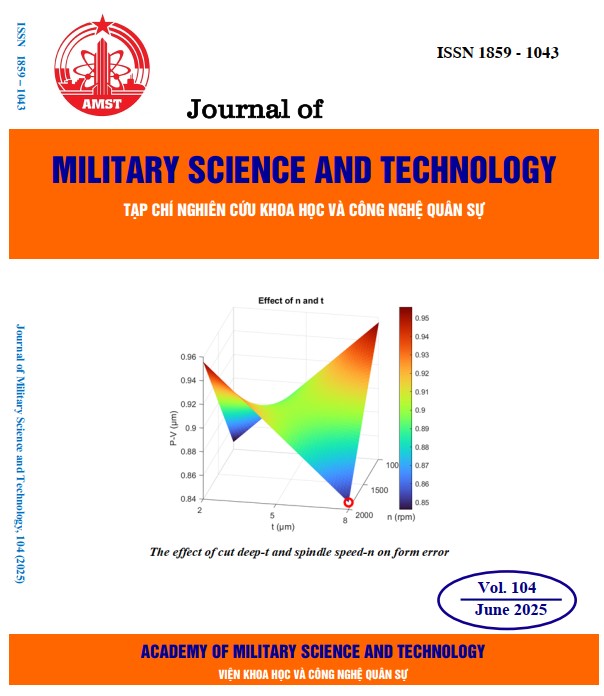Determination of the kinetic parameters of the projectile when penetrating the wooden target by finite element methods
397 viewsDOI:
https://doi.org/10.54939/1859-1043.j.mst.104.2025.164-172Keywords:
Projectile penetration into wooden target; Projectile penetration into steel plate; Fuze test; Penetration depth.Abstract
The inertial force that occurs when a projectile impacts or penetrates depends on various factors, such as the diversity and heterogeneity of the physical and mechanical characteristics of the obstacle, as well as the structural features of the projectile. These factors are not calculated accurately but need to be combined with actual testing to determine. Many studies have been conducted on the process of projectiles penetrating into soil, rock, concrete, as well as research on projectiles penetrating steel plates. However, up to now, studies on bullets penetrating wooden targets are still limited. This is because, in reality, wooden targets are not common battlefield targets. In fuze tests, wooden targets are widely used to ensure safety and standardisation during testing, but the acceleration values obtained to activate the fuze have not been quantified. Based on this reality, this article investigates the applicability of formulas for the process of projectiles penetrating steel targets in order to apply them when calculating the penetration of projectiles into wooden targets. The simulation results identified the critical coefficient when projectiles penetrate into oak wood targets, with projectile sizes ranging from 57 to 100 mm, velocities ranging from 500 ÷ 1000 m/s, and wood thicknesses ranging from 10 to 50 mm, with values ranging around 1320÷1825. The test firing results for a specific case (76mm projectile, 30mm thick target) do not deviate much from the simulation.
References
[1]. Engineering. “Design Handbook. Ammunition Series: Fuzes”. Head-quarters, US Army Materiel Commands, (1969).
[2]. Fuzes. “Military Handbook”. Department of Defense, MIL-HDBK-757 (AR), (1994).
[3]. Robert S. Bernard, Daniel C. Creighton. “Projectile Penetration in soil and rock”. U.S.Army engi-neer waterways experiment station, (1979).
[4]. C.W.Young. “Depth prediction for earth penetrating projectile”. Journal, soil mechanic and founda-tions division American society of civil engineers, vol 95, No SM3, p803-817, (1969). DOI: https://doi.org/10.1061/JSFEAQ.0001285
[5]. Savvateev A.F., Budin A.V., Kolikov V.A. and Rutberg Ph.G. “High-Speed Penetration into Sand”. Int. J. Impact Engng., 26, No. 1, pp. 675-681, (2001). DOI: https://doi.org/10.1016/S0734-743X(01)00132-4
[6]. G.A.Danilin, V.P.Ogorodnikov, and A.B.Zavolokin, “Basics of Designing Cartridges for small Arms”. Balt.Gos. Tekh. Univ., St. Petersburg, (2005).
[7]. L. Koene and F.R.Broekhuis. “Bullet penetration into wooden targets”. 30th International Symposi-um on ballistics Longbeach, CA, September 11-15. (2017). DOI: https://doi.org/10.12783/ballistics2017/16976
[8]. Elina Barone, Baiba Gaujena and Janis Videmanis. “Projectile penetration depth into wood-based frames of unclassified buildings”. Far East Journal of Mechanical Engineering and Physics. Volume 3, Pages 11-20, (2022). DOI: https://doi.org/10.17654/2229451122002
[9]. LA-4167-MS. “Selected Hugoniots”, EOS 7th Int. Symp. Ballistics. Johnson Cook, (1969).
[10]. “Equation of State and Strength Properties of Selected Materials”. Steinberg D.J. LLNL. (1991).







